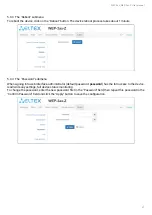
WEP-3ax, WEP-3ax-Z. User manual
36
•
•
•
•
•
•
•
•
•
•
•
•
•
OBSS Coexistence
– automatic channel bandwidth reduction when the air is loaded. When the flag is set,
the mode is enabled;
DFS Support
– dynamic frequency selection mechanism. The mechanism demands wireless devices to
scan environment and avoid using channels which coincide with radiolocation system's channels at 5
GHz:
Disabled
– the mechanism is disabled. DFS channels are not available for selection;
Enabled
– the mechanism is enabled;
Forced
– the mechanism is disabled. DFS channels are available for selection.
Short Guard Interval
– support for Short Guard interval. Access point transmits data using 400 ns Guard
interval (instead of 800 ns) to clients which also support Short GI;
STBC
– Soace-Time Block Coding method dedicated to improve data transmission reliability. When
checked, the device transmits one data flow through several antennas. When unchecked, the device
does not transmit one data flow through several antennas.
Beacon Interval, ms
– Beacon frame sending period. The frames are sent to detect access points. The
parameter takes values from 20 to 2000 ms, by default – 100 ms;
Fragmentation Threshold
– frame fragmentation threshold, bytes. The parameter takes values 256-2346,
by default – 2346;
RTS Threshold
– after what quantity of bytes the Request to Send will be sent. Decreasing of the
parameter's value might improve access point operation when there are a lot of clients connected.
However, decreasing of the parameter's value will reduce general bandwidth of wireless network. The
parameter takes values from 0 to 65535, default is 2347.
Frame Aggregation
– enable support for AMPDU/AMSDU;
Short Preamble
– use of the packet short preamble;
Airtime Fairness
– over-the-air radio accessibility feature. When the flag is set, the function is active –
the airtime is distributed evenly among users.
5.5.3 The "Advanced" submenu
In the
"Advanced"
section, you can configure advanced device’s radio interface parameters.
















































